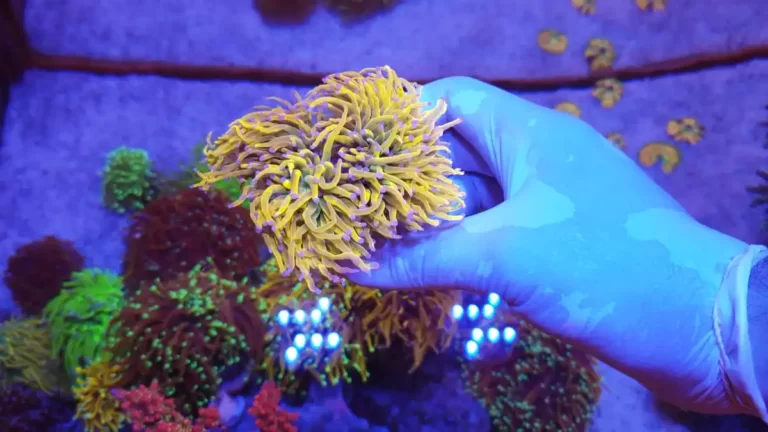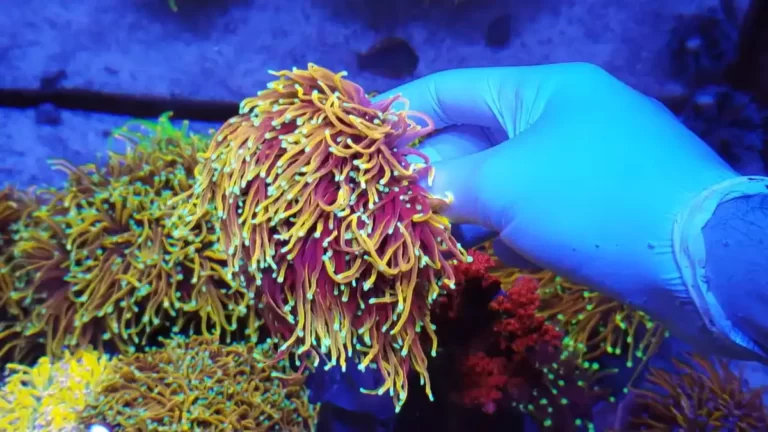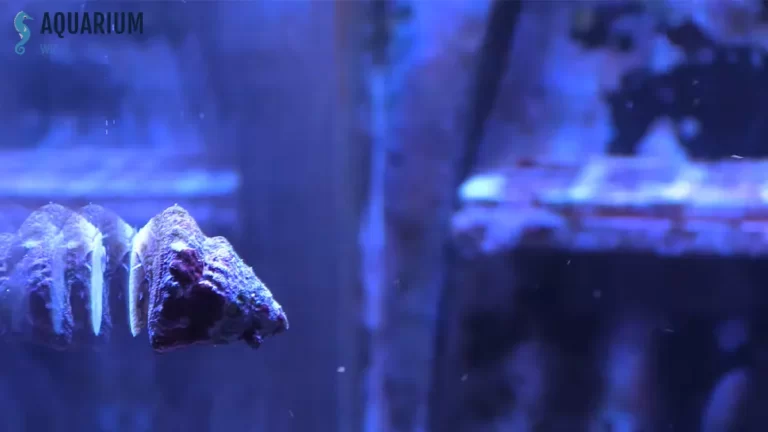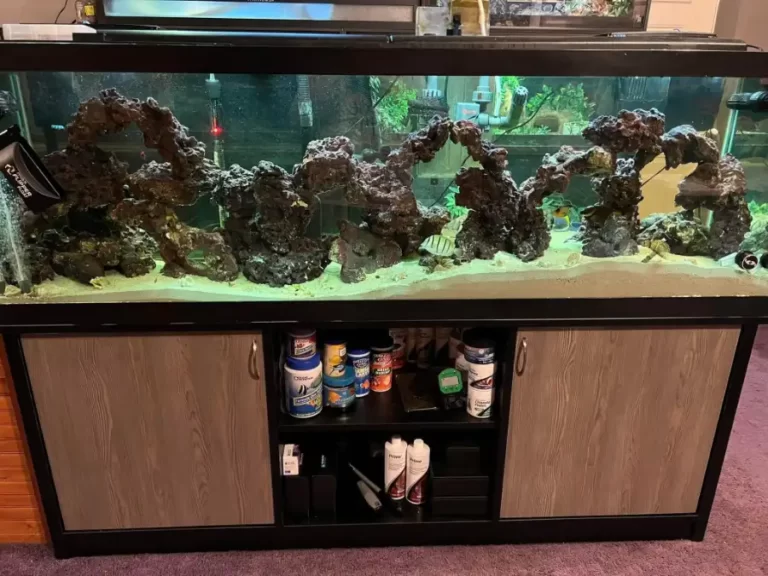Lavender Tang Care : Everything You Need To Know
The Lavender Tang, also known as the Spot-Cheeked Surgeonfish, is a popular saltwater aquarium fish that is native to the Central Pacific.
If you are considering adding a Lavender Tang to your aquarium, it is important to understand their care requirements. From their diet to their tank mates, there are several factors to consider when caring for this fish.
In this article, we will explore everything you need to know about Lavender Tang care, including their size, lifespan, tank mates, and breeding habits.
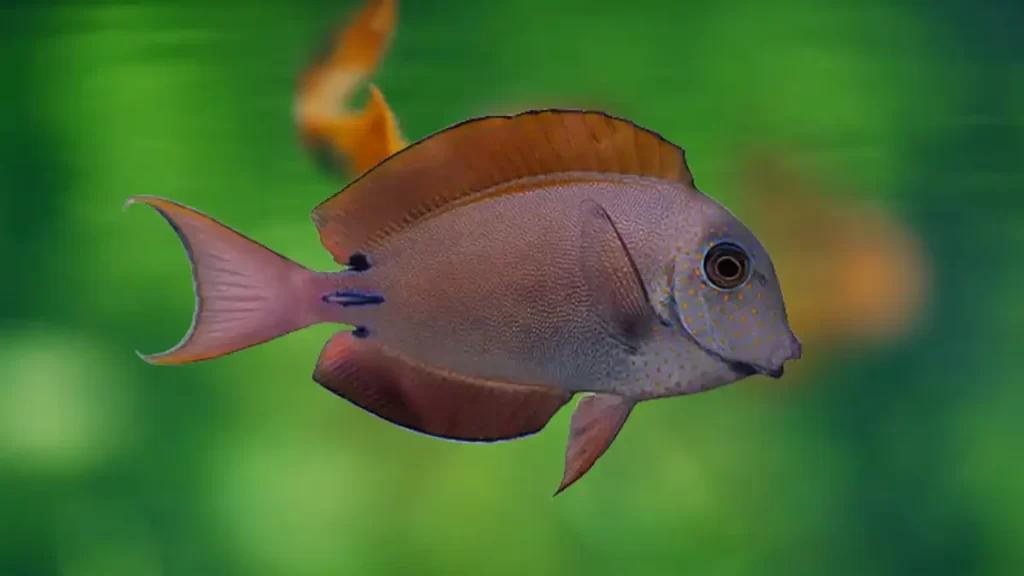
Origins of Lavender Tang
The Lavender Tang, also known as the Spot-Cheeked Surgeonfish, is a popular fish found in the Indo-Pacific and Hawaii. It is a member of the Acanthuridae family, which includes other surgeonfish and tangs.
While the exact origin of the Lavender Tang is unknown, it is believed to have originated in the Indo-Pacific region near Hawaii and the Great Barrier Reef. The Lavender Tang is commonly found in coral reefs and rocky areas, where it feeds on algae and other small organisms.
The Lavender Tang is a relatively new addition to the aquarium trade, having been introduced in the 1990s. It has since become a popular choice for aquarium enthusiasts due to its unique coloration and active behavior.
In the wild, the Lavender Tang can grow up to 21 cm in length, but in captivity, they typically grow to be around 15 cm. They are known for their distinctive lavender and tan coloring, as well as the multiple orange spots on their face. The orange spots give way to many small black spots covering the rest of the body, and the tail is forked.
Physical Characteristics of Lavender Tang
The Lavender Tang, also known as the Acanthurus Nigrofuscus, is a beautiful fish that can grow up to 21 cm in length. It is commonly found in the Indo-Pacific and Hawaii and is a popular choice for aquarium enthusiasts.
Coloration
This fish is known for its unique coloration. It is mostly lavender in color with tan accents and has multiple orange spots on its face. The rest of its body is covered in small black spots, and its tail is forked. The combination of these colors makes the Lavender Tang stand out in any aquarium.
Size
The Lavender Tang can grow up to 21 cm in length, which makes it a medium-sized fish. It is recommended that this fish be kept in a tank that is at least 125 gallons to ensure it has enough room to swim around comfortably.
Behavior
The Lavender Tang is a semi-aggressive fish and can be territorial towards other fish in the tank. It is best to keep this fish with other semi-aggressive fish that are of similar size. It is also important to note that the Lavender Tang is a herbivore and requires a diet that is high in algae and other plant-based foods.
Water Conditions
The Lavender Tang prefers water that has a specific gravity of 1.022 – 1.026, a pH level of 8 – 8.4, and a temperature range of 75°F – 82°F (24°C – 28°C). It is important to maintain these water conditions to ensure the health and well-being of the fish.
Overall, the Lavender Tang is a beautiful fish that requires specific care and attention. It is important to provide it with a suitable environment and a proper diet to ensure it thrives in your aquarium.

Habitat and Distribution
The Lavender Tang, scientifically known as Acanthurus nigrofuscus, is a marine fish species that is widespread in the Indo-Pacific region. It is commonly found in rocky habitats with algae, coastal reefs, harbors, and outer reef gutters and channels up to a depth of about 20 meters.
The Lavender Tang is known to occur in the Red Sea, south to Transkei, South Africa, and east to the Hawaiian and Tuamoto islands. It is also found in the southern Great Barrier Reef, New Caledonia, and Rapa (Austral Islands).
Adult Lavender Tangs are usually found in small groups, but in some oceanic locations, they form large schools. Juveniles are often seen feeding with mixed species aggregations.
The Lavender Tang is a hardy fish species and can adapt to different water conditions. However, it is important to maintain good water quality and provide ample swimming space in the aquarium. The Lavender Tang is a popular fish among hobbyists due to its vibrant coloration and active behavior.
Read More: Accidentally Dumped Fish Food in Tank: What to Do Next
Diet and Feeding Habits
The Lavender Tang primarily feeds on algae and plant matter. It requires a diet that is heavy on greens, and dried brown, red, and green algae (such as nori seaweed) fed to them using a veggie clip will be required. Having lots of live rock in the tank will allow them to graze in between meals.
In addition to algae, the Lavender Tang also enjoys other vegetable matter such as lettuce, spinach, and broccoli. It is important to provide a varied diet to ensure that the fish receives all the necessary nutrients.
It is recommended to feed the Lavender Tang at least twice a day, but smaller, more frequent feedings are better. Overfeeding should be avoided, as this can lead to health problems such as obesity and swim bladder disorders.
It is also important to note that the Lavender Tang is a herbivore and should not be fed meaty foods such as shrimp or fish. These types of foods can cause digestive problems and potentially lead to illness or death.
Overall, providing a varied diet of algae, vegetables, and occasional supplements will keep the Lavender Tang healthy and happy.
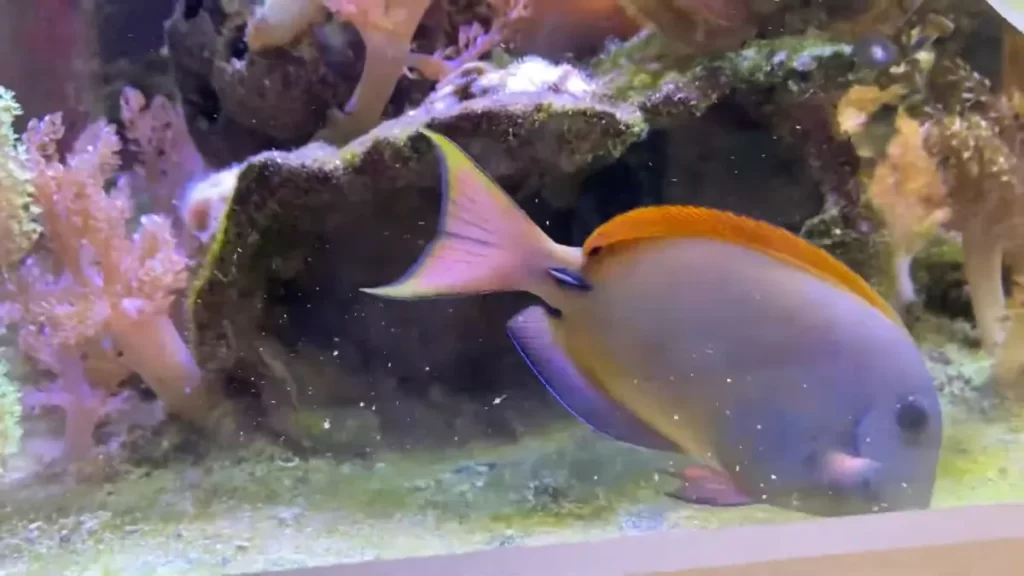
Breeding and Reproduction
The Lavender Tang is a group spawner and open water egg scatterer. They are known to form pairs during breeding and will stay together even within groups. The male Lavender Tang may exhibit color changes during spawning to attract females and to warn rival males.
In captivity, breeding Lavender Tangs can be challenging. It is recommended that they are kept in a large aquarium of at least 90 gallons, with 100 gallons or more being even better. The aquarium should have plenty of swimming room and hiding places.
To encourage breeding, it is important to provide a healthy diet of varied foods, including algae and meaty foods. Some aquarists have had success with using a moonlight simulation to mimic the natural lunar cycle, which can trigger breeding behavior.
Once the eggs are laid, they will hatch within a few days. The larvae will need to be fed small planktonic foods several times a day. The larvae will go through several stages before they reach the juvenile stage, which can take several weeks.
Lavender Tang in Aquariums
The Lavender Tang, also known as the Spot-Cheeked Surgeonfish, is a popular species of fish in the aquarium hobby. This beautiful fish is colored in tones of lavender and tan, and has multiple orange spots on the face. The orange spots give away to many small black spots covering the rest of the body, and the tail is forked. Lavender Tangs have light gray bodies with pastel-like yellow dorsal fins and purple tail/anal fins. They also have small yellow dots on their mouth and face.
Lavender Tangs are relatively hardy fish that can adapt to a range of water conditions. They are best kept in aquariums that are at least 100 gallons in size, as they can grow up to 10 inches in length. It is important to provide them with plenty of swimming room and hiding places, such as live rock or coral structures. They are peaceful fish that can be kept with other non-aggressive species, but caution should be exercised if stocking with other tangs.
Lavender Tangs are herbivores and should be fed a varied diet of algae, seaweed, and other vegetable matter. They may also accept some meaty foods, such as brine shrimp or mysis shrimp. It is important to provide them with a balanced diet to ensure their health and longevity.
Related Post: Bristletooth Tang Care: Everything You Need to Know
Health and Diseases
Lavender Tangs are generally hardy and healthy fish, but they can be susceptible to various diseases and health issues. It is essential to maintain proper water quality and provide a healthy diet to prevent illnesses.
Common Diseases
Here are some of the most common diseases that can affect Lavender Tangs:
- Head and Lateral Line Erosion (HLLE): This disease causes the erosion of the fish’s head and lateral line. It is often caused by poor water quality and inadequate nutrition.
- Ich: Ich is a parasitic disease that causes white spots on the fish’s body. It is highly contagious and can be fatal if left untreated.
- Marine Velvet: Marine velvet is a parasitic disease that causes the fish’s skin to turn a rusty color. It can be fatal if not treated promptly.
- Fin Rot: Fin rot is a bacterial disease that causes the fish’s fins to deteriorate. It can be caused by poor water quality or injury.
Prevention and Treatment
Prevention is the best way to keep Lavender Tangs healthy and disease-free. Here are some tips to prevent diseases:
- Maintain proper water quality by performing regular water changes and using a high-quality filtration system.
- Feed a healthy and balanced diet that includes a variety of foods.
- Quarantine new fish before adding them to the main tank.
- Observe the fish regularly for any signs of illness.
If a Lavender Tang does become sick, prompt treatment is essential. Here are some common treatments for diseases:
- Medications: There are many medications available to treat various fish diseases. It is essential to choose the right medication for the specific disease and follow the instructions carefully.
- Saltwater dips: Saltwater dips can help treat some parasitic diseases. The fish is placed in a container of saltwater for a short period to kill the parasites.
- Isolation: Sick fish should be isolated from healthy fish to prevent the spread of disease.
Overall, with proper care and attention, Lavender Tangs can live long and healthy lives.
Conservation Status
The Lavender Tang (Acanthurus nigrofuscus) is listed as a species of “Least Concern” by the International Union for Conservation of Nature (IUCN) Red List. This means that the species is not currently facing any major threats that could cause significant population declines. However, it is important to note that this status may change in the future if new threats emerge or existing threats become more severe.
One of the main threats to the Lavender Tang is overfishing for the aquarium trade. This species is popular in the aquarium trade due to its attractive coloration and hardiness in captivity. However, overfishing can lead to declines in wild populations and can also have negative impacts on the health and genetic diversity of captive populations.
Another potential threat to the Lavender Tang is habitat loss and degradation. Like many reef-associated fish species, the Lavender Tang relies on healthy coral reef ecosystems for food, shelter, and reproduction. Climate change, pollution, and other human activities can all contribute to the degradation of coral reef habitats, which could have negative impacts on Lavender Tang populations.
Interesting Facts About Lavender Tang
The Lavender Tang is a beautiful fish that can be found in the Central Pacific. Here are some interesting facts about this species:
- Colorful Appearance: The Lavender Tang is named for its stunning lavender and tan coloration. It also has multiple orange spots on its face that add to its beauty.
- Large Schools: These fish are known to travel in large schools on the reefs of the Central Pacific. This behavior is thought to be a way to protect themselves from predators.
- Easy to Care For: The Lavender Tang is considered an easy fish to care for in the aquarium hobby. They require a minimum tank size of 125 gallons and a water temperature between 75°F – 82°F (24°C – 28°C). They also prefer a pH level between 8 – 8.4 and a specific gravity of 1.022 – 1.026.
- Herbivorous Diet: In the wild, Lavender Tangs feed on algae and other plant material. In captivity, they can be fed a diet of algae sheets, spirulina flakes, and other vegetable matter.
- Breeding Can Be Difficult: Breeding Lavender Tangs in captivity can be a challenge. They require a large tank with plenty of hiding spaces and a strict diet to encourage spawning. It is recommended that only experienced breeders attempt to breed these fish.
- Can Be Aggressive: While the Lavender Tang is generally peaceful, they can become aggressive towards other tangs or fish that resemble them. It is recommended that they are kept with peaceful tank mates and not with conspecifics to avoid aggression.
Overall, the Lavender Tang is a beautiful and fascinating fish that can make a great addition to a large, well-maintained aquarium.
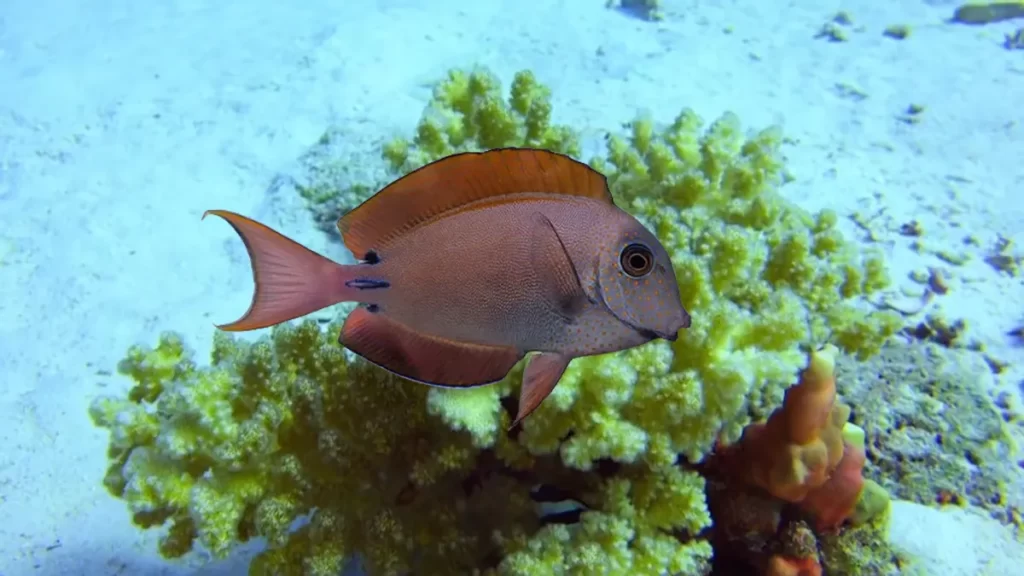
Related Post: Can Expired Fish Food Kill Fish [Explain]
Frequently Asked Questions [FAQs]
What are some good tank mates for a lavender tang?
Lavender tangs can be kept with other tangs as long as they are not conspecifics. It is also important to provide enough space for each fish to establish their own territory. Some good tank mates for lavender tangs include other peaceful fish such as clownfish, gobies, and wrasses.
How large can lavender tangs grow?
Lavender tangs can grow up to 9 inches in length, so it is important to provide a large enough tank for them to swim around in. A tank that is at least 100 gallons is recommended.
What is the typical behavior of lavender tangs?
Lavender tangs are active swimmers and enjoy having plenty of open space to swim around in. They are generally peaceful but can become territorial towards other fish if they feel threatened or if their space is invaded.
Are lavender tangs considered hardy fish?
Lavender tangs are considered hardy fish and can tolerate a wide range of water conditions. However, it is important to maintain good water quality and provide a healthy diet to ensure their long-term health.
Are purple tangs a rare species?
Purple tangs are not considered a rare species, but they can be more difficult to find than other tangs. They are also more expensive than other tangs due to their popularity and vibrant coloration.
Is the lavender tang suitable for a reef aquarium?
Lavender tangs can be kept in a reef aquarium as long as they are well-fed and provided with plenty of swimming space. However, they may nip at certain types of coral, so it is important to research which types of coral are safe to keep with them.
Related Posts:


